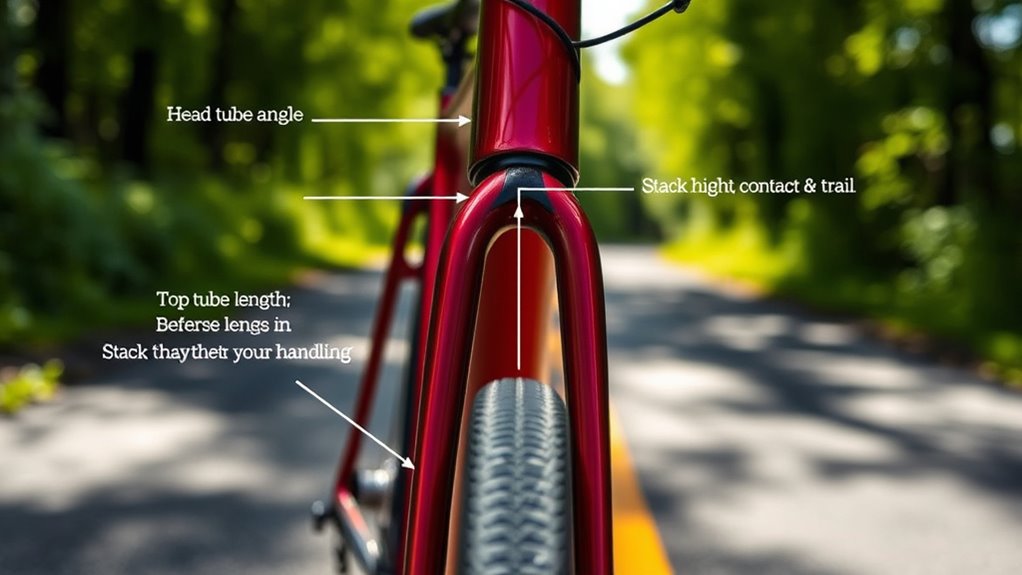Bike geometry includes key measurements like stack, reach, and trail that directly impact your ride. Stack is the vertical distance from the center of the bottom bracket to the top of the head tube, affecting handlebar height. Reach measures how far you extend horizontally, influencing comfort and control. Trail refers to the distance the front wheel’s contact point moves behind the steering axis, impacting stability and steering feel. Understanding these details helps you choose a bike that fits and performs perfectly—explore more to get the full picture.
Key Takeaways
- Stack measures vertical height from the bottom bracket to the top of the head tube, indicating bike height and rider positioning.
- Reach is the horizontal distance from the bottom bracket to the top of the head tube, affecting riding posture and control.
- Trail is the horizontal distance between the front wheel’s contact point and the steering axis, influencing steering stability and responsiveness.
- Proper understanding of these measurements helps tailor bike fit to riding style and terrain.
- Adjusting geometry parameters like stack, reach, and trail optimizes comfort, handling, and overall ride experience.

Understanding bike geometry is essential for choosing the right bike and optimizing your riding experience. When it comes to frame sizing, it’s about finding a bike that fits your body comfortably and allows you to control it effectively. A properly sized frame ensures you’re not overstretching or cramped, which can lead to discomfort or even injury. To determine the right frame size, you need to consider your height, inseam length, and riding style. For example, a taller rider might need a larger frame, while someone smaller benefits from a more compact size. Many bike manufacturers provide sizing charts, but the best way to guarantee a perfect fit is to test ride different options. Proper frame sizing also impacts your riding posture, helping you maintain balance and control, especially during technical sections or sprints.
Suspension geometry plays a vital role, especially on mountain bikes or bikes designed for rough terrain. It influences how your bike handles impacts and how it responds during turns and climbs. The suspension geometry includes angles and lengths that determine the bike’s capability to absorb shocks and maintain stability. If the suspension geometry is too slack, it might feel sluggish and less responsive, making quick maneuvers difficult. Conversely, a steeper suspension angle offers quicker handling but might compromise stability on descents. When selecting a bike, you should consider your typical riding terrain and style to find the right suspension geometry. If you mostly ride on technical trails, a bike with more aggressive suspension geometry can give you better control, while cross-country riders might prefer a more straightforward setup for efficiency.
In addition to frame sizing and suspension geometry, other aspects like top tube length and head tube angle also influence how your bike handles. A longer top tube provides more stretch, which can improve stability at high speeds, but might reduce maneuverability. The head tube angle affects steering responsiveness; a slacker angle offers more stability at high speeds, while a steeper angle makes steering more nimble. When you choose a bike, pay attention to these measurements and how they align with your riding goals. Adjustments like stem length and handlebar height can fine-tune your bike’s fit, but starting with the right frame size and understanding suspension geometry will set a solid foundation for a comfortable, efficient ride. Mastering these elements helps you pick a bike that feels natural and performs well, making every ride more enjoyable. Additionally, understanding the cookie policies related to website data helps ensure a smooth and personalized browsing experience while researching your ideal bike.
Frequently Asked Questions
How Does Bike Geometry Affect Riding Comfort?
Bike geometry directly impacts your riding comfort by influencing ergonomics optimization and long-distance comfort. A more relaxed geometry, with a lower stack and longer reach, helps reduce strain on your back, neck, and wrists, making longer rides more enjoyable. Conversely, aggressive geometries can cause discomfort over time. By choosing a bike with suitable geometry, you guarantee better posture, less fatigue, and a more comfortable ride, especially on extended trips.
Can Geometry Adjustments Improve Bike Handling?
Yes, adjusting bike geometry can improve handling. You might want to contemplate frame flexibility, which affects responsiveness, and tire clearance, impacting stability and control. Slight changes in head tube angle or fork offset can make steering more precise, while wider tire clearance allows for better grip and shock absorption. These tweaks help you tailor your bike’s handling to your riding style, making rides smoother and more confident.
What Is the Ideal Geometry for Beginner Riders?
As a beginner, you should choose a bike with a frame sizing that fits your height and inseam comfortably. Opt for a slightly relaxed geometry with a shorter reach to make handling easier. Adjust your saddle height so your leg is almost fully extended at the bottom of each pedal stroke. This setup provides stability and confidence, helping you learn basic skills without feeling overwhelmed by complex geometry.
How Often Should Bike Geometry Be Checked or Updated?
You should check your bike’s geometry every few months or after any major crash, upgrade, or frame sizing change. If you ignore it, your ride might become uncomfortable or even dangerous. Regularly inspecting component compatibility and ensuring your frame remains properly aligned keeps your bike performing at its best. Don’t wait for discomfort—think of it as giving your bike a health check to keep you safe and riding smoothly!
Does Bike Geometry Vary Between Different Cycling Disciplines?
Yes, bike geometry varies between cycling disciplines. For example, mountain bikes with suspension types and durable frame materials often have slack angles for stability, while road bikes prioritize aerodynamics with more aggressive geometries. You’ll find that cross-country bikes balance weight and efficiency, whereas downhill bikes emphasize control. Your choice depends on your riding style, terrain, and frame materials, all influencing geometry to optimize performance and comfort.
Conclusion
Understanding bike geometry is like having a secret map to your perfect ride. By mastering stack, reach, and trail, you can tailor your bike to feel just right beneath you. Think of these measurements as the blueprint for comfort and control, guiding you to ride with confidence. Once you get the hang of it, you’ll navigate every turn and straightaway with the ease of a skilled dancer—your bike becomes an extension of yourself.








